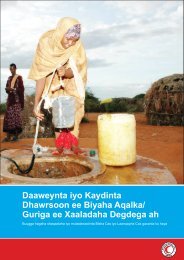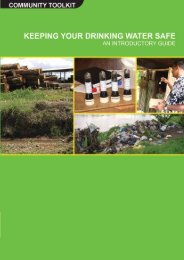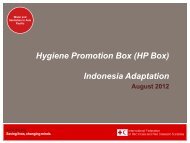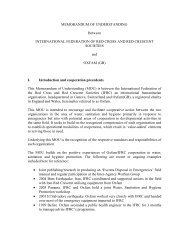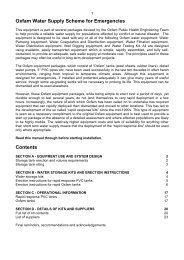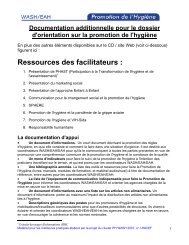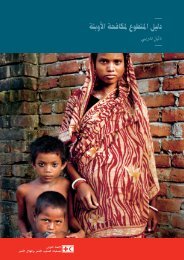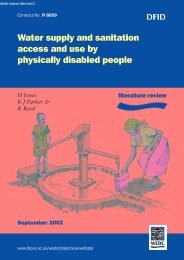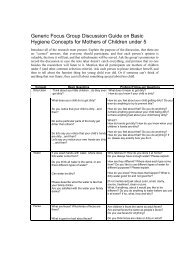Hygiene Promotion - IRC International Water and Sanitation Centre
Hygiene Promotion - IRC International Water and Sanitation Centre
Hygiene Promotion - IRC International Water and Sanitation Centre
Create successful ePaper yourself
Turn your PDF publications into a flip-book with our unique Google optimized e-Paper software.
groups, <strong>and</strong> facilitators of participatory hygiene promotion need to be sensitive to theattitudes <strong>and</strong> culture of each group.Those in charge of programmes <strong>and</strong> projects often have problems in accepting this. Theyreason that if people know what makes them ill <strong>and</strong> how to prevent it, they willautomatically change their practices, no matter what that will cost them in money, time,conflicts <strong>and</strong> criticism. It is not like that in the real world. Convenience, status, esteem <strong>and</strong>financial gain are the stronger driving forces that affect people’s decisions on manyaspects of their lives.There are many more concrete <strong>and</strong> therefore more powerful incentives for water,sanitation <strong>and</strong> hygiene improvements than the promise of better health. These incentivesdiffer for different groups:• Women <strong>and</strong> children appreciate less hardship <strong>and</strong> more time for rest, play (children)<strong>and</strong> schooling.• Men sometimes discount such benefits on the basis that there is no need for schoolingof women <strong>and</strong> girls <strong>and</strong> idleness breeds laziness. Income-generating potential <strong>and</strong>peer pressure are more important incentives for the men.• Among those in the higher socio-economic group, lower groups that are climbing up oraspire to do so, <strong>and</strong> groups with urban contact, increased social status <strong>and</strong> followingopinion leaders <strong>and</strong> trends are important motivating factors.• Willingness to pay for improved sanitation is much higher in densely settled areas thanin areas with lots of space <strong>and</strong> vegetation.In using motivating factors of the user groups themselves, promoters also need to beaware of countervailing forces. Often, the promoted hygiene behaviour also has certaincosts, such as requiring that women <strong>and</strong> girls invest resources that they are short of, <strong>and</strong>cannot control, such as time, money <strong>and</strong> criticism from other family members. Forexample, mothers-in-law or husb<strong>and</strong>s have commented negatively on wasting water in drytimes, or money they spend on good hygiene has been seen as wasteful. In many cultures,women <strong>and</strong> girls generally already work longer hours than boys <strong>and</strong> men, <strong>and</strong> morehygiene work competes with other tasks. They can also often not impact behaviours ofother family members. A targeted approach in which the main goals are agreed, <strong>and</strong>different groups for different practices are identified <strong>and</strong> are addressed through a family,peer group <strong>and</strong> community approach on is thus important for durable success.Specialist health communicators have developed models to try to encapsulate the ways toinfluence hygiene behaviour while respecting local cultures <strong>and</strong> beliefs. Two of thesemodels date from 1993, <strong>and</strong> may need to be updated to take account of more recentexperiences with participatory approaches. The concepts though are helpful when planninghygiene promotion activities.John Hutley relates influences <strong>and</strong> actions to a BASNEF Model (see table 1). BASNEFst<strong>and</strong>s for Beliefs, Attitudes, Subjective Norms <strong>and</strong> Enabling Factors. It is an acronym thatdoes not exactly roll off the tongue, but is intended to include all the factors involved.<strong>IRC</strong> <strong>International</strong> <strong>Water</strong> <strong>and</strong> <strong>Sanitation</strong> <strong>Centre</strong> 15



